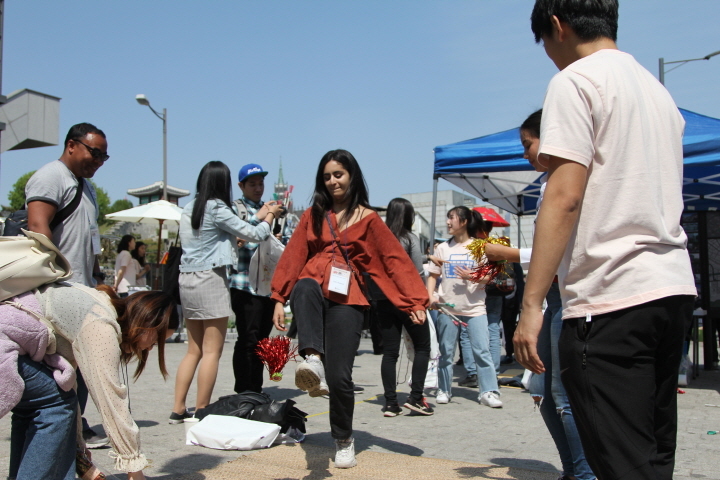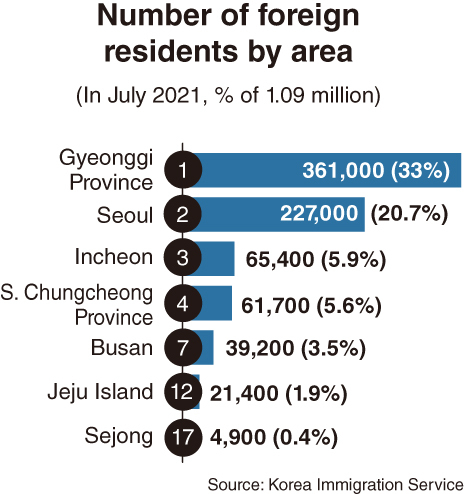[News Focus] Tally for foreigners in Korea slides to 62-month low
Gyeonggi, Seoul, Incheon rank top 3 in residential locations
By Kim Yon-sePublished : Aug. 31, 2021 - 17:06

SEJONG -- The tally for foreigners staying in South Korea has continued to drop for more than a year after peaking at 2.52 million in December 2019 in the aftermath of the pandemic.
The number of foreign nationals -- both long-term and short-term visitors -- posted 1.974 million as of July, down more than 6,000 from 1.981 million a month earlier, according to the Korea Immigration Service.
This marked the lowest in 62 months since the figure stayed at 1.949 million in May 2016.
On a yearly basis, the number of foreigners broke through the 1 million-mark for the first time in history in 2007, steadily climbing to 1.39 million in 2011, 1.57 million in 2013, 1.89 million in 2015, 2.18 million in 2017 and 2.52 million in 2019. But it retreated to 2.03 million in 2020.
Compared to December 2019, the number of long-term visitors -- people staying in the nation 91 days or longer -- decreased by 9.7 percent (168,253) to 1.56 million in July 2021.
Further, the figure for short-term visitors -- those with permission to stay in Korea for no more than 90 days -- plummeted by 48.2 percent (382,262) to 410,591 over the corresponding period.

The sharper drop among short-term visitors is likely due to a marked fall in the number of inbound travelers for sightseeing or business.
Chinese still made up the greatest portion of the total, with 852,204 Chinese nationals staying in Korea as of last month, though the figure slid by 22.6 percent from 1.10 million in December 2019. Ethnic Koreans from China, or Chinese citizens of Korean descent, made up more than 73.3 percent (624,753) of the 852,204 Chinese here.
The number of Vietnamese and Thais trailed after, accounting for 209,293 and 174,363 people, respectively. Many of these were laborers or wives of Korean men who had extended their stay here, while others chose to visit despite the pandemic.
Coming in fourth was the US with 148,663 people, including about 28,500 US military troops stationed here.
Next were people from Uzbekistan at 65,993, Russians at 48,322, Filipinos at 47,920, Cambodians at 41,189, Mongolians at 38,487, Nepalese at 37,198, Indonesians at 35,101 and those from Kazakhstan at 30,370.
While the tally for long-term and short-term visitors declined 21.8 percent compared to December 2019, the number of Japanese visitors showed a noteworthy drop over the corresponding 19-month period.
In December 2019 there were 86,196 Japanese nationals in Korea, and the country was No. 5 in the number of expatriates staying in the nation. But it had fallen to No. 13 as of July 2021 with just 27,607 Japanese staying here, representing a 67.9 percent decline.
By age, those in their 30s made up the largest proportion with 27.6 percent (545,298 people), followed by those in their 20s with 21.2 percent (419,294), those in their 40s with 16.8 percent (332,353) and those in their 50s with 15.3 percent (302,882).
The average age of foreigners in Korea remained under 40, while the average age of South Koreans reached 43.5 as of last month.
Of the 1.56 million long-term visitors, the number of registered foreign residents came to 1.09 million.
Of the 1.09 million, 33 percent (361,131) were residing in Gyeonggi Province, followed by 20.7 percent (227,112) in Seoul, 5.9 percent (65,453) in Incheon and 5.6 percent (61,754) in South Chungcheong Province.
Among the next on the list were 64,140 in South Gyeongsang Province, 51,132 in North Gyenongsang Province, 39,293 in Busan and 35,639 in North Chungcheong Province.
Daegu and Jeju Province ranked 11th with 26,958 and 12th with 21,452, respectively, among the 17 major areas in Korea. Sejong had the least number of foreign residents at 4,951 (0.4 percent of registered foreign residents).
By Kim Yon-se (kys@heraldcorp.com)




![[Herald Interview] 'Amid aging population, Korea to invite more young professionals from overseas'](http://res.heraldm.com/phpwas/restmb_idxmake.php?idx=644&simg=/content/image/2024/04/24/20240424050844_0.jpg&u=20240424200058)


![[Pressure points] Leggings in public: Fashion statement or social faux pas?](http://res.heraldm.com/phpwas/restmb_idxmake.php?idx=644&simg=/content/image/2024/04/23/20240423050669_0.jpg&u=)











